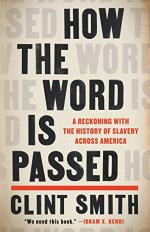|
This section contains 678 words (approx. 2 pages at 400 words per page) |

|
How the Word Is Passed Summary & Study Guide Description
How the Word Is Passed Summary & Study Guide includes comprehensive information and analysis to help you understand the book. This study guide contains the following sections:
This detailed literature summary also contains Topics for Discussion on How the Word Is Passed by Clint Smith.
The following version of this book was used to create the guide: Smith, Clint. How the Word Is Passed. Hachette Book Group, 2021.
Clint Smith's How the Word Is Passed is a work of nonfiction. The text is an examination of the history of slavery in American culture and society. Although Smith's text is analytical and intellectual, his overarching explorations are also grounded in his personal experience. He is particularly using his visits to a range of historical sites in order to learn more about his national and ancestral past. Each chapter of the text therefore presents Smith's experiences traveling to and visiting these sites. Each setting in turn offers Smith an organic gateway into his explorations concerning history, education, and identity. The following summary abides by a similar structural pattern, and relies upon the present tense.
In the prologue, writer and researcher, Clint Smith, outlines the inspirations behind and goals for How the Word Is Passed. He explains that after a Robert E. Lee statue was removed from his New Orleans hometown, he became interested in teaching himself more about the history of slavery in the States.
In "Monticello Plantation," Smith travels to Thomas Jefferson's former plantation, Monticello. While here, Smith attends a tour led by a guide named David Thorson. Although the information David provides the visitors is not new to Smith, he is taken aback by the baldness with which David presents the history of chattel slavery in America and at Monticello. After the tour, Smith talks with two other visitors named Donna and Grace. Although self-proclaimed history buffs, the women confess that they knew little about Jefferson, his beliefs, and his plantation before their visit.
In "The Whitney Plantation," Smith visits the Whitney Plantation in Wallace, Louisiana. Throughout his time touring this property, Smith is moved by the ways in which the museum centralizes the voices, lives, and stories of the people it once enslaved. His conversations with his tour guides and with the museum's owner John Cummings, also expand his thinking on history, education, and the past.
In "Angola Prison," Smith tours Angola Prison with an acquaintance named Norris Henderson. Formerly interned at Angola for a crime he insists he did not commit, Norris possesses an intimate knowledge of the Angola facility and its operations. Throughout his time visiting Angola, Smith is unnerved by the institution's denial of its racist past. By way of contrast, Norris underscores the ways in which his time at Angola made him feel as if he were reliving his ancestors' enslavement.
In "Blandford Cemetery," Smith visits Blandford Cemetery in Petersburg, Virginia. Originally established by the Ladies' Memorial Association, the cemetery houses the bodies of thousands of Confederate soldiers (118). Instead of interrogating its inception and preservation, Smith finds that guides at and visitors to the cemetery believe in the site's historic and symbolic significance. After leaving Blandford, Smith begins to muse on the relationship between history and identity.
In "Galveston Island," Smith attends a Juneteenth celebration held on Galveston Island. Throughout this event, Smith is struck by how little he was taught about his ancestral past. He also realizes the symbolic significance of Galveston and Juneteenth.
In "New York City," Smith attends a walking tour through Manhattan's Financial District. Contrary to expectations, the tour reveals New York's history of racism and enslavement. After the tour, Smith visits Liberty Island. Throughout this tour, Smith interrogates the history of and inspiration behind the Statue of Liberty.
In "Gorée Island," Smith travels to Senegal. From Dakar, he takes a ferry to Gorée Island, where he tours the House of Slaves. This historical site was the place enslaved Africans were held before their oppressors shipped them into bondage overseas. Smith's experiences and conversations while in Senegal further impress upon him the profound nature of his ancestors' suffering.
In the epilogue, Smith visits the National Museum of African American History and Culture with his grandparents. Afterwards, he conducts an interview with both his grandfather and grandmother. These conversations teach him the importance of his family's stories to his understanding of self.
Read more from the Study Guide
|
This section contains 678 words (approx. 2 pages at 400 words per page) |

|



